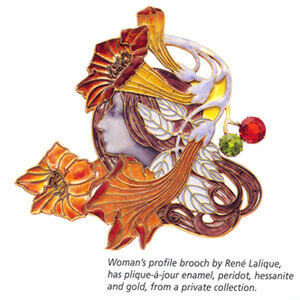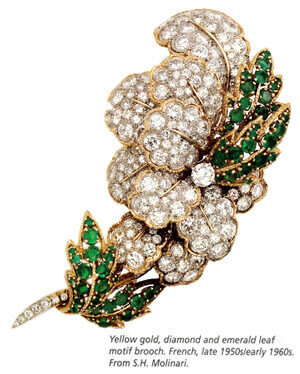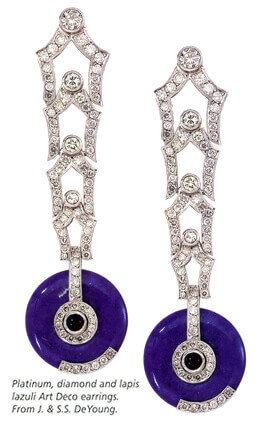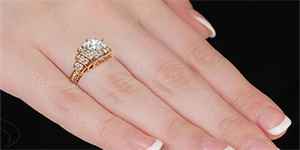
Motifs from nature including insects, birds (especially peacocks and swans), serpents, undulating vines, leaves, flowers (irises, orchids, poppies, water lilies, winded sycamore and maple seeds are favorites in the style's botanical repertoire), the female face and figure (nude and clothed), fantasy figures and "whiplash" curves were all part of the Art Nouveau aesthetic. Japanese decorative arts also influenced Art Nouveau jewelry designs.
 
Sigfried Bing opened his L'Art Nouveau gallery in Paris in 1895. Ren'e Lalique exhibited Art Nouveau jewels at Bing's gallery and at the 1900 Exposition Universelle in Paris. Bing was awarded the Grand Prix at the expo. Tiffany and Co. exhibited and received awards at the 1901 Pan-American Exposition in Buffalo, New York. The Art Nouveau style was at its peak of popularity during the Edwardian period

Gold and silver were the preferred metals during the Art Nouveau period. Natural materials, such as clarified horn and ivory, were often combined with glass and enamel - especially plique-a'-jour, a transparent enamel without a metal backing. Cabochon gemstones, such as opals and moonstones, as well as pearls were incorporated into designs featuring stylized motifs from nature. Diamonds and faceted colored gemstones were added to accent or outline a design's details.

Ren'e Lalique, Henri Vever, Licien Gautrait and Georges Fouquet were foremost among France's delineators of the Art Nouveau style. In the U.S., Paulding Farnham for Tiffany & Co., Marcus & Co., and Newark, New Jersey, manufacturers such as Riker Bros., Krementz & Co., Alling & Co., Whiteside & Blank and Bippart, Griscom & Osborn translated the style for American taste. |

Also knows as "the garland style", Edwardian Engagement rings and jewelry was inspired by the decorative elements adorning eighteenth-century French Louis XVI furniture and objects such as bows, ribbons, wreaths, urns, stars, crescents and, of course, garlands of small floral and foliate motifs. Open trelliswork and millegrained knife-edge wires and collets created the appearance of lace in saw-pierced platinum mounts set throughout with circular cut diamonds.
 
The Boer War began in South Africa in 1899 and consequently prices for De Beers reserve stock rose. Queen Victoria died in 1901 and the coronation of her eldest son, Edward VII took place the following year. Edward VII died in 1910, but the style that bears his name continued into the 1920s. Louis Comfort Tiffany exhibited his jewelry designs for the first time at the 1904 St. Louis, Missouri, World's Fair. In 1910, the Ballets Russes performed Sch'ehe'razade in Paris, inspiring a trend toward colorful and exotic designs the greatly influenced the decorative arts - including jewelry - in the following decade. August Victor Louis Verneuil received U.S. patents for his flame fusion process for synthetic rubies in 1904 and for blue sapphires in 1911. The U.s. National Stamping Act, requiring the marking of gold and silver content, was enacted in 1906. The Cullinan Diamond, which was 3,106 carats in its rough form, was presented to Edward VII in 1907. Joseph Asscher cleaved the diamond in 1908. The Cullinan I, a 530.20-carat pear-shaped stone, and Cullinan II, a 317.40-carat cushion-shaped stone, were mounted in the Scepter and Imperial State Crown for the coronation of George V in 1911. The same year, Evalyn Walsh McLean purchased the Hope Diamond from Cartier. The Titanic sank in 1912

Platinum was by far the most often used metal until World War I. Platinum-topped yellow gold was seen in high-end jewels of the early Edwardian period and also in less expensive jewelry of the teens and 1920s. Karl Gustav Richter in 1915 and the Belais Brothers in 1917 patented alloys for white gold, which were used as a substitute for platinum during and after World War I. Diamonds, pearls and moonstones were favored for the all-white "garland style", but high-quality, large faceted colored gemstones were often used as a focal point for an otherwise all-diamond and platinum jewel.

In France, Cartier was the delineator of the garland style. In Russia, the guilloch'e enamels of Faberg'e were likewise representative of the period. In the U.S., Tiffany & Co. and Marcus & Co. produced designs the rivaled those of the French haute Joailliers. Newark, New Jersey, manufacturers were influenced by both the Art Nouveau and Edwardian styles. |

The Art Deco style reflected a compendium of influences and motifs including stylized flower baskets, bowls and vases; graceful animals such as gazelles, greyhounds and panthers; and fountains, ziggurats (graduated stepped pyramidal shapes, like skyscrapers), streamline and "speed" motifs with parallel lines, geometric and angular shapes. Egyptian, Oriental and (East) Indian designs elements and colors co-existed with all-white pav'e diamond and platinum jewels. Flat, compacted two-dimensional geometric designs of the 1920s became more three-dimensional, open and chunky in the 1930s. Flexible strap or narrow bangle bracelets worn in multiples and long pendent earrings were the dernier cri of the 1920s. Wider open link bracelets - stacked on one arm or both - and dress clips - worn singly or in pairs along the top edge of an evening gown - were the signature look of the 1930s.
 
Prohibition, the eighteenth amendment to the U.S. Constitution, was enacted in 1919 and repealed in 1933. Also in 1919, Walter Gropius, who espoused the concept that "form follows function" and all excess ornamentation should be avoided, founded the Bauhaus School in Germany. U.S. women succeeded at last in winning the right to vote with passage of the nineteenth amendment in190. L'Exposition internationale des arts de'coratifs et industriels modernes was held in Paris in 1925; it became the derivation for the style name "Art Deco' in the 1960s. The first movie "talkies" were introduced in 1927. The stock market crashed in 1929. Ernest Oppenheimer became chairman of De Beers in 1930. The Diamond Products Association and the Diamond Trading Company (TDC) were formed in 1933. Harry Winston opened a retail jewelry business in New York City in 1932.

Platinum was back in widespread use after World War I; white gold was popular for less expensive jewelry. Pav'e set diamonds were often accented with caliber cut colored gemstones - rubies, sapphires, emeralds and onyx in strong contrasting combinations. Carved jadeite of Oriental influence, carved rubies, sapphires and emeralds from India ("tutti frutti" or "fruit salad"), coral, rock crystal and pearls were all popular gemstones for Art Deco jewels.

French haute joilliers Cartier, Van Cleef & Arpels, Boucheron, Mauboussin, Lacloche Fre'res and Rubel Fre'res and avant-garde designers Raymond Templier, Gerorges and Jean Fouquet and Jean Dunand defined Art Deco style for Europeans. In the U.S., Cartier New York, Tiffany & Co., Black, Starr & Frost, Raymond Yard and manufacturing jewelers Oscar Heyman & Bros. and William Scheer, Inc. interpreted the style for American tastes.

Terraces vintage style engagement ring |